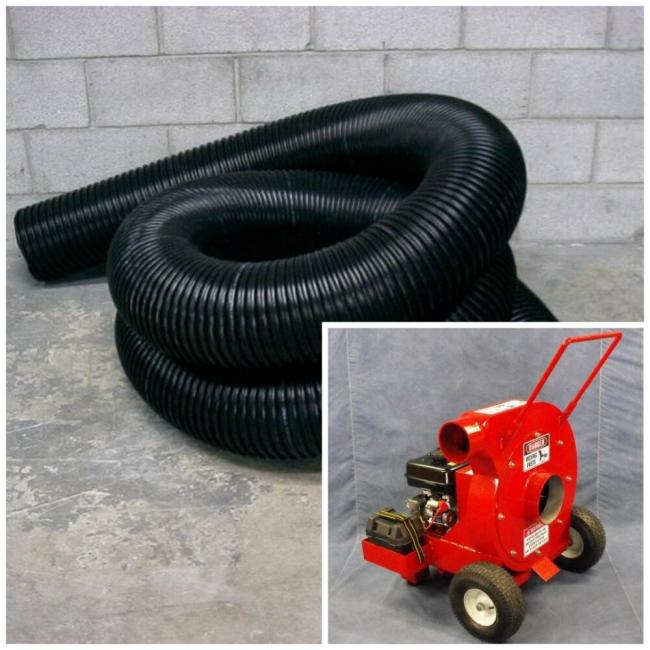Insulation Removal Vacuum Guide: How To Prevent Clogs During Operation

Nothing slows down an insulation removal job like a clog in the hose. An instant time killer, it makes an already intense and difficult job that much more complicated – no matter if you are dealing with fiberglass, cellulose, or mixed materials.
As an insulation contractor with tons of jobs lined up, we know that is the last thing you want. To save yourself from this situation, we recommend getting the right insulation vacuum and ensuring you use it correctly.
Clogs can arise when suction drops or stops entirely. However, the good news is that it is avoidable. With the help of a handful of the right strategies, you can prevent unwanted disruptions on-site.
In this blog, Heat Seal Equipment Ltd., providers of Canadian-made insulation equipment, will show how you can achieve peak efficiency during every job. Let’s begin!
What Are The Best Ways To Prevent Clogs During Insulation Removal?
If you have got the right insulation removal vacuum by your side (such as the one Heat Seal Equipment Ltd. offers), you can avert nasty clogs onsite by following the tips we have listed below:
Choose your hose wisely
Did you know the diameter and condition of the hose you use can dramatically affect its performance? A narrow hose can adversely impact how insulation travels. If you want to achieve smooth material movement and airflow, you should opt for a 6-inch suction hose.
However, before every job, you must inspect it for soft spots or crushed sections, coupler tightness, bends, and the presence of old insulation in interior walls. If you find any of these issues, resolve them promptly. Debris build-up or partial collapse can dramatically reduce airflow and increase the chances of clogs.
Keep hose runs short
The possibility of friction and slow flow of materials is much higher during longer hose runs. Although they might be unavoidable in certain cases, you can still reduce clogs by keeping the first 20-30 feet of your hose as straight as possible so insulation material gets enough space to move.
We strongly recommend avoiding sharp 90-degree bends as debris can accumulate there quickly. You must also ensure your hose does not sag in sections for the same reason. Lastly, using gradual, sweeping turns instead of sharp movements to keep your hose from getting bent out of shape.
A word of advice? If you have to run your hose through an attic hatch or a window, provide enough padding under its entry point to prevent sagging and obstruction.
Position your vacuum correctly
It is not a commonly known fact, but the way you position your insulation removal vacuum onsite can affect its performance. To ensure optimal material flow, you must place your vacuum as close to the access point as possible. Uphill house routing is best avoided as it makes gravity work against you, thus leading to unwanted build-up.
Furthermore, you must ensure the insulation removal vacuum bag attached to your setup has enough room to expand fully. Keeping the discharge side of your vacuum unobstructed is a great way to prevent material back-up.
Remember, any restrictions in the discharge path will cause your vacuum to push insulation slowly, which can lead to the clogging of either the discharge port or the insides of the hose.
Never overfill bags
Of all the causes of clogs, allowing your insulation removal vacuum bag to overfill is the chief among them. Though designed to hold large volumes of discarded material, they need some amount of empty room to maintain airflow.
Overfilled bags compromise breathability, which in turn forces the resistance back to the vacuum, thus leading to slower removal. We suggest stopping as soon as the bag reaches its recommended capacity. Swapping it out at the right time will help you maintain optimal airflow.
Conclusion
Clogs happen. While you may not be able to do much to instantly get rid of them once they do, you can certainly prevent their occurrence by adopting the strategies we have listed above.
Another thing that can help? Using the right equipment.
Heat Seal Equipment Ltd., Ontario’s best supplier of insulation removal tools, is here to help you. Engineered for high-volume performance, our machines and accessories guarantee peak efficiency. Contact us to get tools that help in speeding up every job.
FAQs
Can hoses of smaller diameter help in the prevention of clogs?
No. They actually restrict airflow and increase the chances of clogs. It is best to use recommended hose sizes to maintain optimal performance.
How long can a hose run before it loses its suction power?
Most professionals prefer keeping their hose runs within the bracket of 100-150 ft. However, the layout of your site and hose material can affect its length.
When should insulation removal hoses be replaced?
If your hose looks crushed, has soft spots, or has excess interior build-up, you should replace it.





